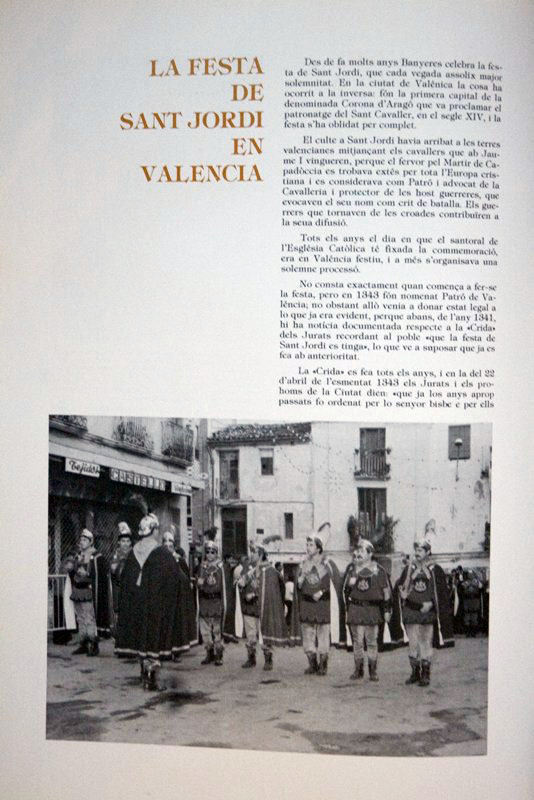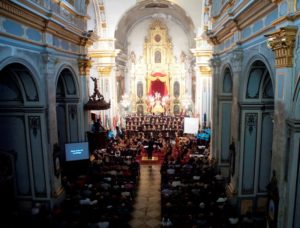For many years Banyeres has been celebrating the feast of Sant Jordi, which attains ever greater solemnity. In the city of Valencia the opposite has happened: was the first capital of the so-called Crown of Aragon that proclaimed the patronage of the Holy Knight, in the fourteenth century, and the party has been completely forgotten.
The cult of Sant Jordi had arrived in the Valencian lands through the knights who came with James I, because the fervor for the Martyr of Cappadocia was widespread throughout Christian Europe and was considered a Patron and Advocate, of the Cavalry and protector of the host warriors, which evoked his battle cry name. The warriors returning from the crusades contributed to its spread.
Every year the day on which the Catholic Church is commemorated, it was in Valencia festive, and a solemn procession was organized.
It is not clear exactly when the party begins, but in 1343 he was named Patron of Valencia; nevertheless that came to give legal status to what was already evident, because before, of the year 1341, there is documented news regarding the “Shout” of the Jury remembering the town “that the feast of St. George is had”, which comes to suppose that it was already done ab before.
The “Shout” it is done every year, and in the 22 April of the mentioned 1343 the Jury and the leading men of the City say: “that already the near past years were ordered by Mr. bishop and by them in any year perpetually, the feast of the Blessed Saint George, knight of God, cultured siga and celebrada solemnialment”.
Details of the processions years later are available. Leaving the Cathedral, and passing by the Bishop's palace (It should be noted that the diocese of Valencia was not promoted to archbishopric until 1492) and in front of the church of Sant Andreu they were going to enter the church of Sant Jordi, by the street that bore the name of the saint to be precisely in front of one of the doors of the temple, next to what was on the walls a door that is also St. George's Day.
They formed in the procession the Offices with their flags, priests, canons, generous knights and citizens, nobles, Jury, Justice, Síndic, Rational, Clerks, Bishop and all kinds of authorities - sometimes even the Viceroy - accompanied by music of ministers, horns and tablas. There was also the Hundred of the Feather.
For years the procession had to be postponed on the saint's own day, for some reason, usually because, as the chronicles say, havien “a lot of mud”, which in those days greatly hindered traffic. So it happened in 1608, that the 3 May, in a 1635 that the 2 of July.
The 23 d'April 1638, the procession took place but it happened that the church of Sant Jordi was almost destroyed and the procession could not enter, so an altar was erected in the street, in which the usual ceremonies were performed.
In addition the procession to Sant Jordi on the occasion of its festivity, was also celebrated on 9 October, anniversary of the conquest of Valencia by James I, date that had special splendor the years that the centenaries were fulfilled.
The church dedicated to St. George was completed and was consecrated in 1401; the Priory of the Order of Sant Jordi d’Alfama was installed in it, that it was an old Catalan monastic-military community that already took part in the conquest accompanying king Jaume I. The Commander of the Order participated, ab his cavalry, in the siege of the capital, forming part of the army deployed in the southwest, in the Patraix area. Of course, had compensation in the Cast. He moved to the new temple exactly one year after the Order joined the Valencian of Montesa, and as the Priorat was respected, the Prior himself, From Gil Dalvir, who continued in office, moving from one Order to another, although as it is natural pertaining to Montesa. This church of Sant Jordi was demolished in 1861, but at present a parish exists that has it by holder.
The Hundred of the Pen, the troops that the City had for its service and for the safekeeping and escort of the Senyera, was instituted by King Peter the Ceremonious by privilege granted in 3 June 1365. He had St. George as Patron, and for this reason he is sometimes called the Company of the Hundredth of St. George. The two magazines that passed each year were precisely on St. George's Day and 9 October.
Many of those belonging to the Hundred of the Feather wanted to create a Brotherhood of a religious nature, ab the purposes of these associations, on the whole beneficial. And having requested it from Peter the Ceremonious, he acceded to the wishes expressed and granted the privilege on 19 of July of 1371.
Upon taking office, the Jurors of Valencia took the oath before the relic of a bone of Sant Jordi that was in the chapel of the Casa de la Ciutat, for which it is done in 1596 a reliquary for the Valencian goldsmith Eloi Camanyes. It is preserved in the Municipal Historical Museum, and it is a beautiful work of art, in which the figure of the saint is represented in the classical form: wielding a spear, which has nailed to the dragon that is under the riding horse.
In the church of the Temple, which was taken over by the Order of Montesa in the 18th century, there was a chapel dedicated to St. George. It was that of Communion, in which there was a bust-reliquary of the saint, silver, that I disappeared in 1812, replacing it with another of silver metal, which also disappeared in 1936. There are currently no images. The Redemptorist Fathers now run this church.
As another note of the devotion to the Holy Knight in the City of Valencia it should be noted that among the “Roques”, triumphal chariots that traditionally parade through the streets following the route of the Corpus Christi procession, a little before this - there was one in which the image of Saint George with the dragon went. Estes “Roques” they have been done in various data, and they didn’t come out the same every year, agreeing to the Jury which ones were to participate; the one we are referring to is among those of the year 1512, and it is possible that it became unusable due to the flooding of the premises where they were kept, by a great flood, l’any 1517.
One of the galleys provided by the City of Valencia in 1419 to King Alfonso the Magnanimous for his actions in Naples, fon, as stated in the agreements of the Council, “nicknamed St. George”, which shows how the name of the Martyr of Cappadocia was kept in mind in many details.











